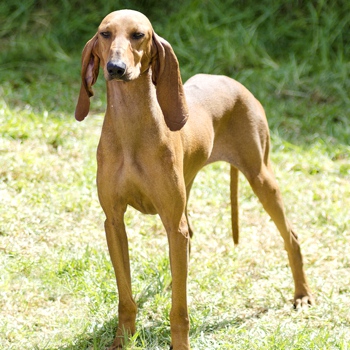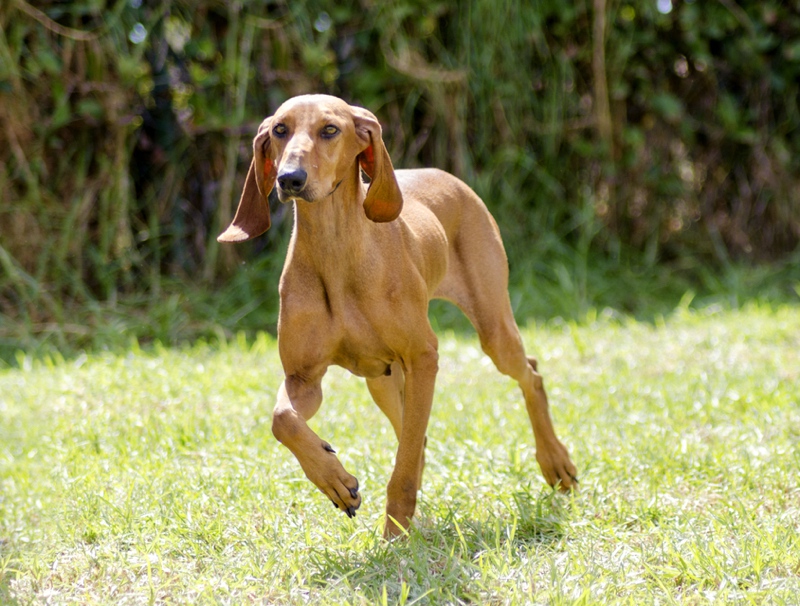Segugio Italiano

The Segugio is an Italian scent hound that has been on the trail of wild boar in its homeland for at least the last 2000 years, and remains a very popular breed there today. Don’t be surprised, however, if you’re not familiar with the Segugio, for not a single one has been registered in the United Kingdom in the past 10 years, meaning anyone wanting to acquire one of these beautiful dogs will need to source it from abroad. As a hound, it has a strong urge to hunt, but it is now just as often kept as a pet, and it is a kind, gentle character that is suitable for any home without small pets. As one might expect from a pack animal, it is very sociable with other dogs.
Part of the Segugio’s hunting technique involves baying loudly and melodiously when on a scent trail. In this way, it can startle any prey in hiding, causing them to run in front of the hunter’s gun. It can also use this voice to good effect as a watch dog, but its musical qualities might not be appreciated by neighbours, so the Segugio should not be left alone and bored, when it is most likely to start singing. It is a breed intended for long periods of vigorous exercise, and must be afforded the same when living as a pet in order to prevent obesity and frustration setting in. Remarkably, there are no recognised inherited health problems in the Segugio Italiano, and it has a life expectancy of 11 to 13 years.
About & History
This is truly an ancient breed, although claims that it was brought to Italy by Phoenician traders are impossible to prove. In support of this theory, some have pointed out the breed’s physical similarities to other Middle Eastern dogs, such as the Pharaoh Hound, but DNA evidence of their relationship is lacking. What is more likely is that the Segugio originated in ancient France (or Gaul) in pre-Roman times with the Segusian tribe of the region, and was adopted by the Romans upon their invasion of the country.
The infamous Emperor Caliguli was known to hunt with a pack of these dogs, and the Segugio was often depicted around this time in statues of Diana, the Goddess of Hunting. Examples of such sculptures may be found in museums in Italy, the Vatican, and elsewhere in Europe.
Segugios traditionally hunted in very large packs of up to several hundred individuals, and it was not only as adept as the Bloodhound in tracking prey, it also had the instinct and will to capture or kill it in the hunter’s absence. The breed’s popularity, or at least its fame, seemed to peak during the Renaissance, as it was a favourite muse of many painters, but demand for the Segugio’s services decreased in the following centuries, and it became somewhat rare by the late nineteenth century.
Thankfully, it was revived, possibly with the introduction of some Mastiff blood into the pedigree, and was also moulded into a dog that could work in smaller packs, or even alone, making it a more versatile working dog. This, in turn, made it more appealing to individual hunters, and though it has never really succeeded in making it beyond the confines of the Italian borders, it is now ranked as one of the ten most popular dog breeds in its native land.
Appearance

The Segugio Italiano is a dog of medium proportions, with a strong frame and lean, muscular build. Its large, long head is divided equally in length between muzzle and skull, with their outlines diverging slightly when viewed from the side, giving the Segugio the Roman nose that is seen in several of the Italian breeds. The skull is markedly oval-shaped when seen from above, and the muzzle is as broad as one would expect in a dog so dependent on its keen sense of smell. Its lips are fine and thin, and the upper lip does not overhang the lower jaw. The Segugio’s almond-shaped eyes are a dark shade of ochre, and always carry a kindly expression, while its wide, triangular ears are set low on the side of the head and are drawn forward by their shape so as to reach well down the length of the muzzle.
The neck is in the shape of a truncated cone, and has long, slender muscles, giving it an almost dainty aspect. In outline, the body fits neatly inside a square, with the back being as long as the dog is tall. Its frame is broad and solid, but not bulky, and the arches of the withers and loin are not very pronounced. The Segugio has an unusually thin tail that is set high on the croup and reaches almost to the hock. Its chest is deep, but not very wide, and the abdomen is flat, without an obvious tuck.
The limbs are long and lean, with good joint angulation, and the lower limbs have sufficient bone density to withstand the twists and knocks of traversing uneven ground. The paws have tight, well-arched toes, dense interdigital hair, and tough, leathery pads; features that again help when hunting over rough terrain. The Segugio Italiano may have either a short, smooth coat, or a longer, wiry one, meaning individuals can have very different superficial appearances. The hair is either some shade of fawn or a combination of black and tan in colour, with some small white markings being permissible. Males weigh between 20 and 28 kg, and females 18 to 26 kg, with respective height ranges of 52–58 and 48–56 cm.
Character & Temperament
Despite its hunting prowess, the Segugio is a kindly, gentle dog that can adapt very well to life as a family pet – at least, in homes without cats or other small animals. As is typical of a hound, it exhibits a certain amount of independence, and is not clingy, but it does need plenty of company, either having a family member available at all times, or being allowed to spend a small portion of the day with other dogs. It is an excellent watch dog, and will reliably bark when it hears something suspicious, but it is not aggressive, and is no danger to visitors to the home.
Trainability
Although the Segugio might be a little stubborn, it is also an intelligent dog and reasonably eager to please, so it can usually be trained quite easily once given appropriate incentives in the form of praise and the occasional treat. Its musical voice can create a headache for neighbours, especially if the dog is bored or restless, and teaching a “silent” command can form a very useful part of the training regime for any young Segugio.
Health
Unfortunately, there are few other breeds that can claim to be as healthy as the Segugio Italiano. From the currently available evidence, it does not seem to be particularly predisposed to any of the common ailments we are all used to seeing in pedigrees. This is not to say that it cannot develop any number of health problems – simply that it is no more likely to do so than any other dog. The only potential problem that can arise because of the Segugio’s conformation is:
Gastric Dilatation & Volvulus
This condition occurs most commonly in dogs undertaking vigorous exercise too soon after eating, and involves an abrupt rotation of the stomach around its long axis. This torsion obstructs the exit of food and fluids from the stomach, causing it to bloat dramatically.
Signs include rapid abdominal distension, unproductive retching, weakness, and collapse. Emergency surgery is required to prevent this becoming a fatal problem. GDV is best avoided by feeding small, frequent meals, and by avoiding exercise for at least 90-minutes after eating.
Exercise and Activity Levels
Segugio Italianos are more than capable of spending an entire day hunting in the field, during which time they are almost constantly on the move, and they have stamina in abundance. However, they are generally quite low-energy dogs at home unless something excites them, when they are capable of bursting into action. Nevertheless, they do need a great deal of exercise to maintain their physical and mental wellbeing, and owners should plan on devoting at least two-hours every day to walking or other activities.
Grooming
Smooth-coated individuals may only need weekly brushing, but those with the wiry form of the coat may also need to have it hand-stripped several times per year to remove dead hair and promote healthy growth. The Segugio has black nails, and although these need to be clipped every few weeks, it may be necessary to have this done by a groomer or veterinary nurse, at least until the owner is confident in how much can be safely removed without catching the vascular quick running down the nail’s centre.
Famous Segugio Italianos
While it may not be the breed of choice for many celebrities, the Segugio Italiano has been immortalised in sculptures of Diana, the Roman Goddess of Hunting, which can be seen on display in the museums of Naples, the Vatican, and elsewhere around the world.
Cross-Breeds
This is truly a rare breed in most of the world, and is not used in any cross-breeding programmes at the present time.

